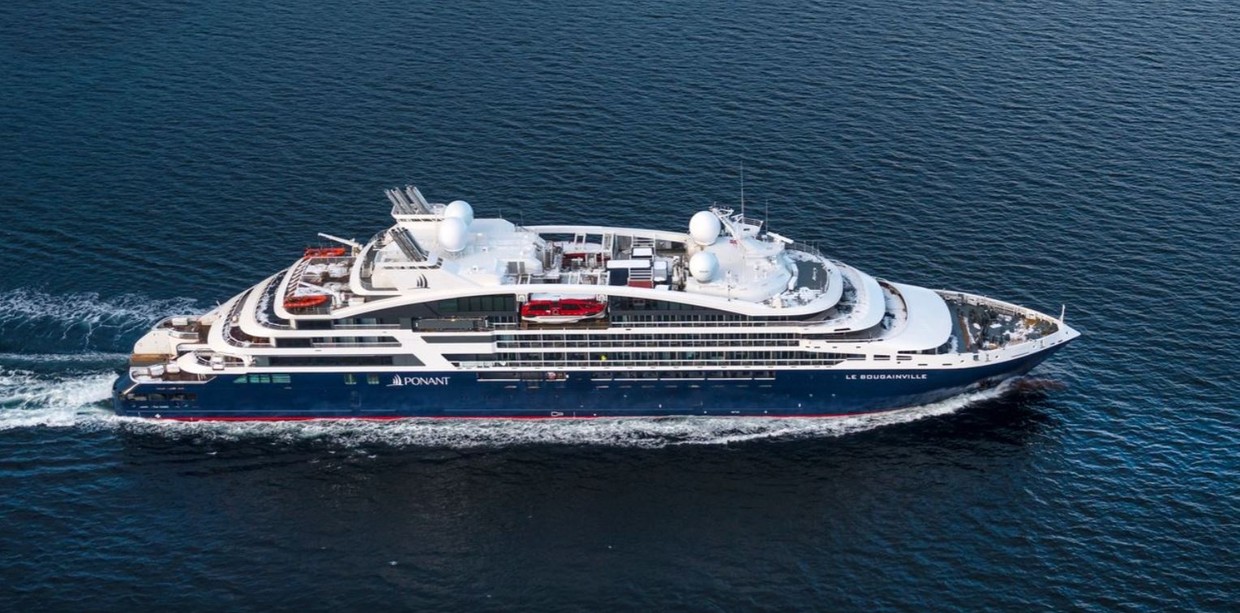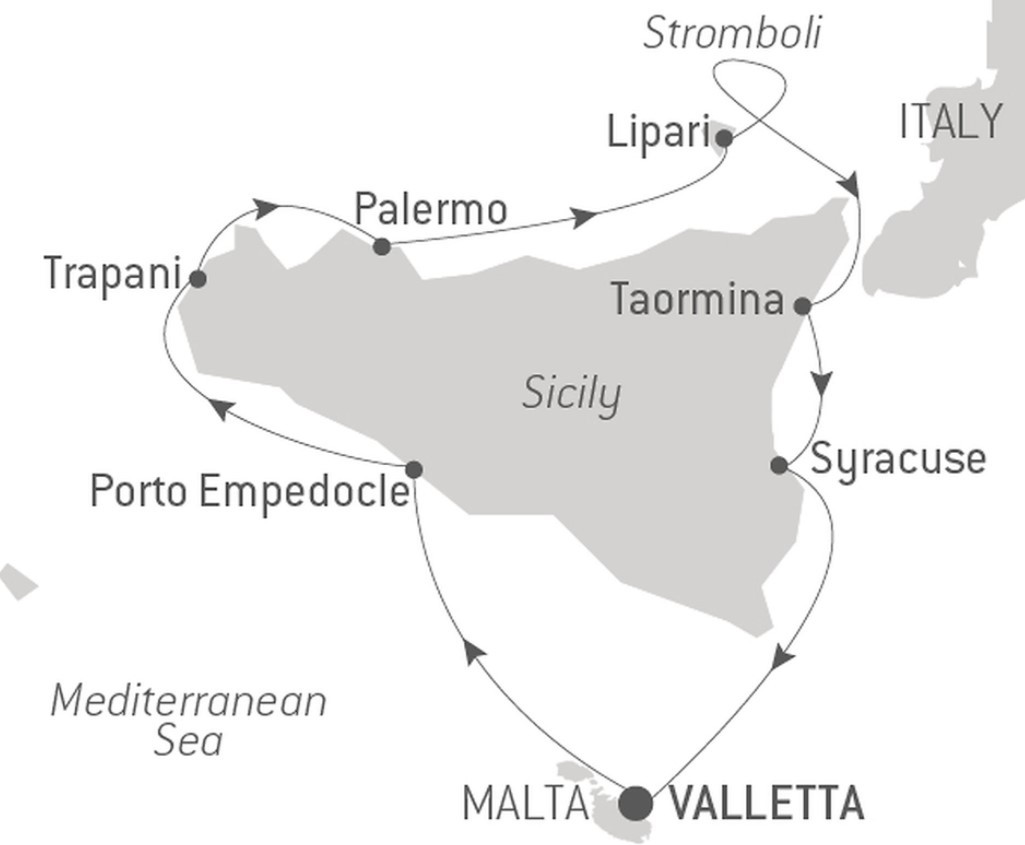2022-04-08
2025-01-01
Note: Current p/p indicative rate. Final price may change due to currency fluctuations.
In alliance with Smithsonian Journeys. We invite you to join us on a circumnavigation of Sicily, a crossroads of the many historical civilizations—Greek, Roman, Arab, Byzantine, Norman—that have flourished along the shores of the Mediterranean. Setting sail from Malta, your first stop is Porto Empedocle, gateway to the fabled Greek temples of Agrigento, among the most captivating ruins in the entire Mediterranean. Rounding the western tip of the island, you arrive in Trapani for an excursion into the countryside and the ancient Doric temple of Segesta or to medieval Erice, perched on a high triangular plateau sloping down to the sea. Your fourth day aboard Le Bougainville brings you to Palermo, founded by the Phoenicians in 827 BC and becoming one of Europe’s greatest cities in the 12th century, when the Normans took control. Here you will visit Cappella Palatina, a Byzantine-Arab-Norman structure featuring dazzling mosaics and magnificent inlaid marble floors and walls. Or drive to nearby Monreale to explore its famed Norman cathedral. In Lipari, discover the 16th-century Norman castle-turned-archaeological museum on the site of an ancient acropolis before sailing in the evening to Stromboli, whose active volcano provides the backdrop as you cruise around the island. From Stromboli, your ship sails through the Strait of Messina to arrive at Taormina on Sicily's east coast. Visit a winery on the slopes of Mount Etna, the largest active volcano in Europe, or tour Taormina town with its emblematic Greek theater offering dramatic views of the coastline. The final port of call before your voyage comes to an end in Valletta is Syracuse, colonised by Greeks in the 8th century BC only to grow to rival Athens as one of the most powerful cities of the ancient world. You will visit the Roman Amphitheater of Augustus and the 15,000 seat Greek theater or Ortygia, the old town and its Baroque cathedral.
The whole of the Maltese capital Valletta is UNESCO World Heritage listed and occupies a peninsula in the north-east of the island. From the fountain of Tritons to Saint-Elme fort, there are as many majestic streets as there are narrow staircase vennels to explore. The painted loggia and carved corbels on the tall houses will accompany you in your explorations, and you’ll rarely be bothered by traffic. You can visit the Grandmasters palace decorated with coats of arms and frescoes. Saint-John’s cathedral and the ramparts which have guarded the city since the 16th century are also among the most emblematic sites of the city. Arranged in terraces, the Barrakka Gardens will punctuate your promenade with a green and floral experience.
Huddled on the south-western coast of Sicily, Porto Empedocles bears the name of the philosopher Empedocles, who lived in the region in the 5th century BC. An age-old city offered up to sun and sea, this is your doorway to the exceptional archaeological site of Temple Valley, a high place of Greek civilisation listed as a UNESCO World Heritage site. You can admire the remains of many temples dedicated to Zeus, his wife Hera and Hephaestus. Make sure you take in the magnificent Italian countryside, with its olive orchards that cover the hillsides.
Bathed in the cobalt waters of the Tyrrhenian sea, Trapani is the former port of the Greek city of Erice, boasting a privileged natural position in western Sicily. As you wander through its little streets, you will discover a secular cultural heritage, bearing witness to the many influences of civilisations that came here: San Lorenzo Cathedral, Maria Santissima Annunziata sanctuary, the fountain of Triton. On the shaded restaurant terraces, savour some fresh fish from the morning’s catch. Or else you can opt for a seafood couscous, a culinary legacy from their Arab neighbours.
Palermo is the guardian of the Sicilian soul. Many have been attracted to this city, the largest capital of the Italian islands. Phoenicians, Carthaginians, Romans, Byzantines, Arabs, Normans... Palermo is a rich culmination of so many cultural influences as seen in the Moorish designs on the cathedral, and the Byzantine mosaics of the Palatine chapel, which is itself housed within the precincts of the Norman palace. You will fall under the spell of the palaces, baroque splendours that grace the town with their obsolete beauty. It is thrilling to stumble upon one of those fabulous markets, high in colour, and headily picturesque.
Of the seven Aeolian islands, this is the largest and the most populated. Lying off the north coast of Sicily, in the Tyrrhenian sea, Lipari is one of UNESCO’s marvellous World Heritage sites. Its lava stone quarries and obsidian flow of Rocce Rosse are indications of its volcanic nature. The town, the largest urban area in the whole archipelago, proudly houses its citadel and its castle, both rooted in Antiquity. If you head further into the centre, you’ll be surprised to come across a Norman cathedral, complete with a magnificent baroque façade. Like Ulysses during his Odyssey, you will have the opportunity to admire the Stromboli, the capricious volcano that looms over the Aeolian Islands. Its activity, uninterrupted for thousands of years, has earned it the nickname the “Lighthouse of the Mediterranean”.
Located on Sicily’s eastern coast, in the province of Messina, the seaside town of Taormina is Sicily’s Saint-Tropez, boasting heritage sites, secluded beaches and luxury shopping. You can visit its medieval centre, suspended 300 metres above sea level, where terraces offer a spectacular view of the Mediterranean Sea. Another vestige from its past are the ruins of the Greco-Roman theatre. This extremely well-preserved site attracts visitors who are fascinated by the natural beauty of the area which overlooks a turquoise bay.
Its undulating rocky coastline, the endless sandy beaches, the menacing form of Mount Etna which surveys its island like a patriarch, the flowery gardens on the hillside... Sicily lays out its varied landscapes like a shopkeeper displays his wares. Described by Cicero as “the most beautiful city in the world”, Syracuse was one of the most prestigious cities in Sicily and at her height was even a rival for Athens. A central city of Ancient Greece, it was home to a succession of civilisations, each of which has left their mark. The blend of Arabic, Roman, Norman, Byzantine and Spanish cultures makes Syracuse a town that is extraordinarily rich in fragrances, colours and flavours.
The whole of the Maltese capital Valletta is UNESCO World Heritage listed and occupies a peninsula in the north-east of the island. From the fountain of Tritons to Saint-Elme fort, there are as many majestic streets as there are narrow staircase vennels to explore. The painted loggia and carved corbels on the tall houses will accompany you in your explorations, and you’ll rarely be bothered by traffic. You can visit the Grandmasters palace decorated with coats of arms and frescoes. Saint-John’s cathedral and the ramparts which have guarded the city since the 16th century are also among the most emblematic sites of the city. Arranged in terraces, the Barrakka Gardens will punctuate your promenade with a green and floral experience.
This cruise is part of a collection of PONANT voyages that are specially-tailored for English-speaking travellers who want to engage with the world. In addition to the usual elements of the PONANT experience, the listed price for these voyages includes transfers to and from the ship, talks and discussions aboard ship by world class experts, and a shore excursion or activity in each port of call that encourages guests to embrace the sights, sounds, tastes, and smells of the local environment and culture.

Vessel Type: Luxury Passenger Capacity: 92 cabins Built: 2017/2018 Featuring innovative and environmentally-friendly equipment, elegantly designed cabins, spacious suites with large windows, and lounge areas that open onto the outside, this new limited-capacity yacht boasting just 92 cabins and suites will offer you a truly unique cruising experience. As the first ship in a new series that remains true to the Ponant spirit, Le Bougainville will embody the unique atmosphere that is the cruise line’s hallmark: a subtle blend of refinement, intimacy and comfort. Aboard this ship that flies the French flag, you will experience the incomparable pleasure of an intimate cruise, with the possibility of exploring an ever-increasing range of destinations in an ethnic-chic ambiance with luxury service. Experience a luxurious setting where the accent is on authenticity and passion for travel. RESTAURANTS As it is an essential part of French culture, gastronomy will naturally have pride of place aboard this new ship. Through its two restaurants, Le Bougainville will invite you on a journey to elegance and epicureanism. In a relaxed atmosphere, a first dining area located on Deck 3 and able to seat 70 will serve grilled meats daily, along with a variety of salads and desserts. To the back of Deck 4, you will find a 260 m² panoramic restaurant which can accommodate all of our passengers in a single sitting. Designed differently to that on our other ships, this dining area, which opens onto the outside, will have a buffet of salads, desserts and cheeses at your disposal. Our discreet and attentive crew will provide table service for hot meals. PUBLIC AREAS Like Le Boréal and its sisterships, Le Bougainville has many common areas that are designed and equipped to meet all of your needs while preserving the intimacy of each passenger. A 140 m² reception area includes: A reception/concierge desk, An excursions desk, The ship’s administrative services, The sales office, manned by our Guest Relations Officer, Our 50 m² boutique which sells clothing, jewellery, beauty products, postcards and various accessories, Toilets accessible to passengers with reduced mobility. A new hydraulic platform with adjustable height provides: Easier boarding than on any other cruise ship, Easier Zodiac embarkation and disembarkation for expeditions, Easier access to the sea for swimming and practising various water sports such as kayaking or paddle-boarding. A pool deck offering: A pool with a panoramic view, equipped with a counter-current swimming system, A pleasant solarium, An outdoor bar and lounge with armchairs and sofas. A 200 m² main lounge which can accommodate all of our passengers to share convivial moments and to host activities organised during the day or evening. Lastly, a theatre that seats 188, equipped with: The latest sound and lighting technology, A LED wall as the stage backdrop, for the projection of high-resolution images and videos.
• A voyage specially-tailored for English-speaking travellers including discussions with experts, transfers before and after your cruise, and an included excursion in each port of call. • Engaging discussions onboard with two Smithsonian Journeys Experts. • Well-preserved Greek ruins in Agrigento, Segesta, Taormina, and Syracuse. • Norman cathedral churches in Erice and Monreale. • Stunning Byzantine-Arab mosaics in the Cappella Palatina in Palermo. • UNESCO World Heritage Sites: Palermo, Monreale, the Aeolian Islands, Taormina, and Syracuse. • The active volcanoes of Stromboli and Etna.
